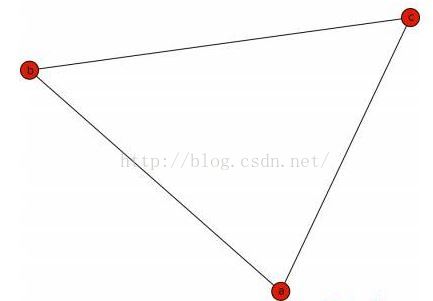http://blog.csdn.net/pipisorry/article/details/49839251
其它复杂网络绘图库
[ArcGIS,Python,网络数据集中查询两点最短路径]
Networkx数据类型
Graph types
NetworkX provides data structures and methods for storing graphs.
All NetworkX graph classes allow (hashable) Python objects as nodes.and any Python object can be assigned as an edge attribute.
The choice of graph class depends on the structure of thegraph you want to represent.
使用哪种图形类
| Graph Type | NetworkX Class |
|---|---|
| Undirected Simple | Graph |
| Directed Simple | DiGraph |
| With Self-loops | Graph, DiGraph |
| With Parallel edges | MultiGraph, MultiDiGraph |
- Graph – Undirected graphs with self loops
- DiGraph - Directed graphs with self loops
- MultiGraph - Undirected graphs with self loops and parallel edges
- MultiDiGraph - Directed graphs with self loops and parallel edges
- Overview
- Adding and Removing Nodes and Edges
- Iterating over nodes and edges
- Information about graph structure
- Making copies and subgraphs
子图subgraphs
Graph.subgraph(nbunch)
参数nbunch指定子图的节点
返回原图上的子图
二分网络
建立二分网络
import networkx
from network.algorithm import bipartite
g.add_edges_from([("nodename1","nodename2"),("nodename3","nodename1")])
判断是否是二分网络
print bi_partite.is_bipartite(g)
得到两端网络
NSet = nx.bipartite.sets(g)
Net1 = nx.project(g,NSet[0])
Net2 = nx.project(g,Nset[1])
networkx的使用
import networkx as nx
使用Python与NetworkX获取数据:基本使用
>>> import networkx as net
>>> import urllib
NetworkX以图(graph)为基本数据结构。图既可以由程序生成,也可以来自在线数据源,还可以从文件与数据库中读取。
>>> g=net.Graph() #创建空图
>>> g.add_edge('a','b') #插入一条连接a,b的边到图中,节点将自动插入
>>> g.add_edge('b','c') #再插入一条连接b,c的边
>>> g.add_edge('c','a') #再插入一条连接c,a的边
>>> net.draw(g) #输出一个三角形的图
你也可以将图的节点与边作为Python列表输出:
>>>> g.nodes() #输出图g的节点值
['a','b','c']
>>>> g.edges() #输出图g的边值
[('a', 'c'), ('a', 'b'), ('c', 'b')]
NetworkX中的图数据结构就像Python的 字典(dict) 一样——一切都能循环,并根据键值读取。
>>> g.node['a']
{}
>>> g.node['a']['size']=1
>>> g.node['a']
{'size' : 1}
节点与边能够存储任意类型字典的属性和任意其他丰富类型的数据:
>>> g['a'] #将临近边及权重作为字典返回输出
{'b': {}, 'c': {}}
>>> g['a']['b'] #返回节点A->B的属性
{}
>>> g['a']['b']['weight']=1 #设置边的属性
>>> g['a']['b']
{'weight' : 1}
多数的计算社会网络指标也返回一个字典,节点ID作为字典键,指标作为字典的值。你可以像操作任何字典一样操作它们。
图Graph
degree(G[, nbunch, weight]) | Return degree of single node or of nbunch of nodes. |
degree_histogram(G) | Return a list of the frequency of each degree value. |
density(G) | Return the density of a graph. |
info(G[, n]) | Print short summary of information for the graph G or the node n. |
create_empty_copy(G[, with_nodes]) | Return a copy of the graph G with all of the edges removed. |
is_directed(G) | Return True if graph is directed. |
节点Nodes
nodes(G) | Return a copy of the graph nodes in a list. |
number_of_nodes(G) | Return the number of nodes in the graph. |
nodes_iter(G) | Return an iterator over the graph nodes. |
all_neighbors(graph, node) | Returns all of the neighbors of a node in the graph. |
non_neighbors(graph, node) | Returns the non-neighbors of the node in the graph. |
common_neighbors(G, u, v) | Return the common neighbors of two nodes in a graph. |
边edges
边相关方法
edges(G[, nbunch]) | Return list of edges incident to nodes in nbunch. |
number_of_edges(G) | Return the number of edges in the graph. |
edges_iter(G[, nbunch]) | Return iterator over edges incident to nodes in nbunch. |
non_edges(graph) | Returns the non-existent edges in the graph. |
有序边
target_subgraph.edges()返回的边是无序的。
修改成有序:sortEdges = lambda l: [(n1, n2) if n1 <= n2 else (n2, n1) for n1, n2 in l]
G.number_of_edges()
方法其实是图类的方法G.number_of_edges()
number_of_edges(self, u=None, v=None):
"""Return the number of edges between two nodes获取属性Attributes
set_node_attributes(G, name, values) | Set node attributes from dictionary of nodes and values |
get_node_attributes(G, name) | Get node attributes from graph |
set_edge_attributes(G, name, values) | Set edge attributes from dictionary of edge tuples and values. |
get_edge_attributes(G, name) | Get edge attributes from graph |
获取边属性get_edge_attributes(G, name)
返回的是一个key为边的dict
edges_weight_index = nx.get_edge_attributes(target_subgraph, 'weight')edges_weight_index[(u, v)]添加边
g=net.Graph() #创建空图
g.add_edge('a','b') #插入一条连接a,b的边到图中,节点将自动插入
批量添加有权边
g.add_weighted_edges_from([(1,2,0.125),(1,3,0.75),(2,4,1.2),(3,4,0.375)])
绘制有权图[Weighted Graph]
[Edges]
ref: [Functions]*
[Networkx Reference]*[NetworkX documentation]*[doc NetworkX Examples]*[NetworkX Home]
[NetworkX sourse code download]
[sciencenet 复杂网络分析库NetworkX学习笔记]*
[networkx笔记系列]





















 549
549

 被折叠的 条评论
为什么被折叠?
被折叠的 条评论
为什么被折叠?








